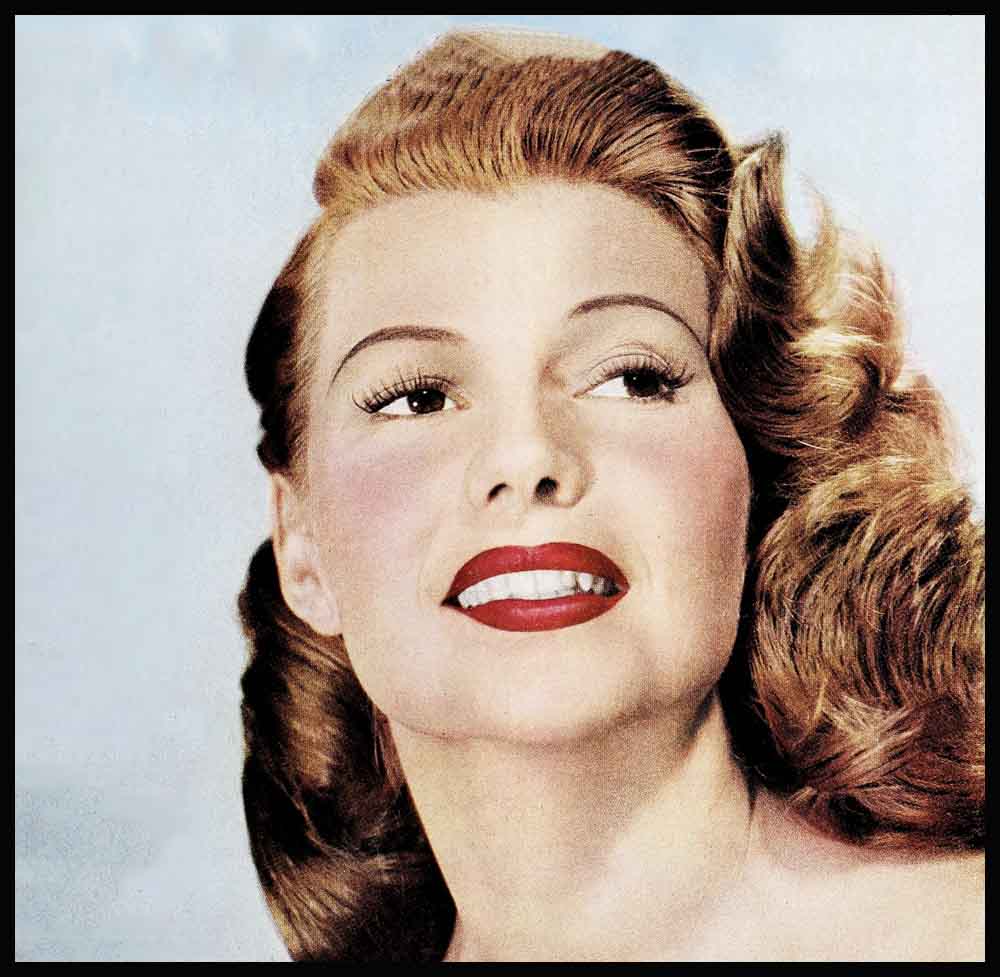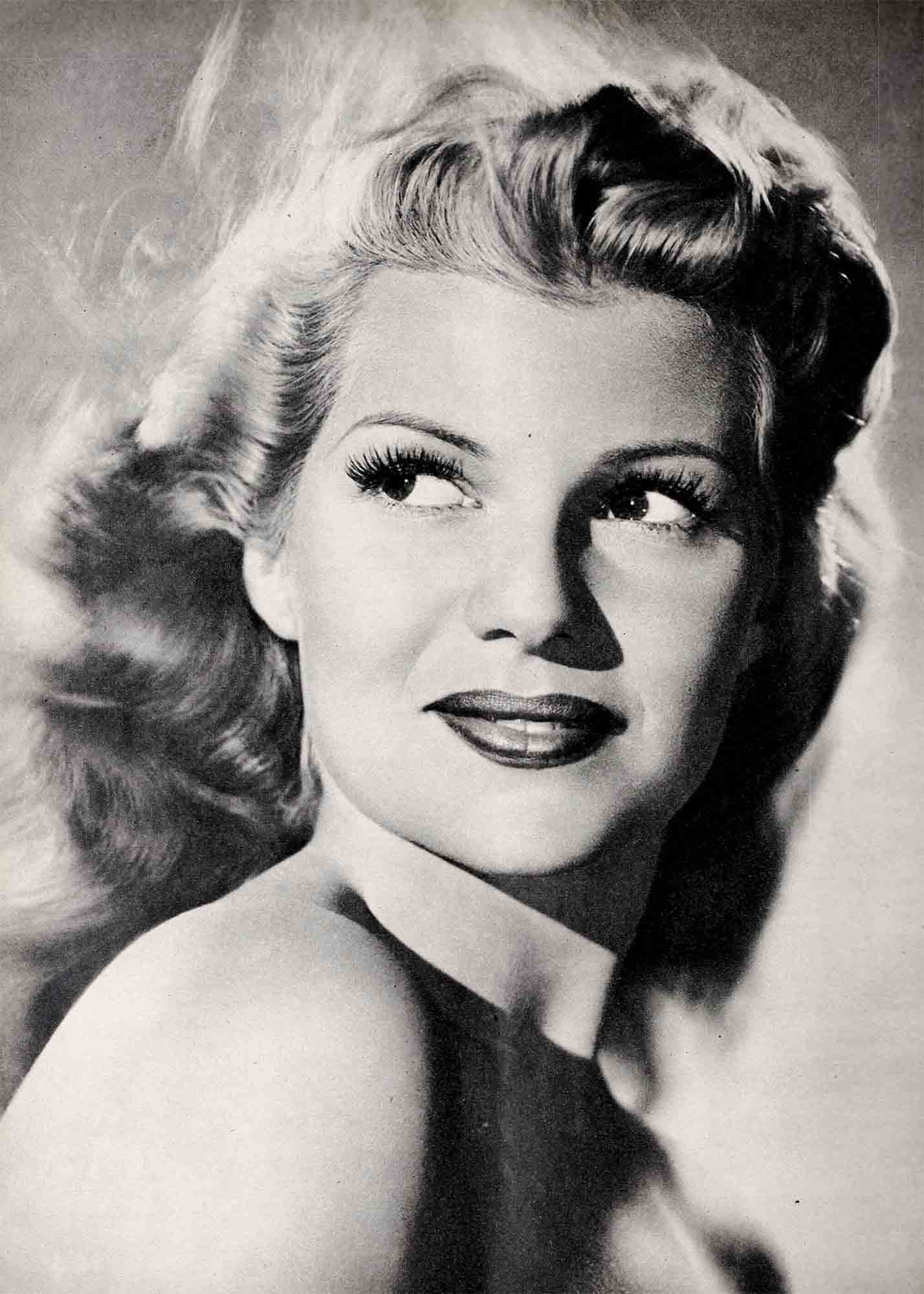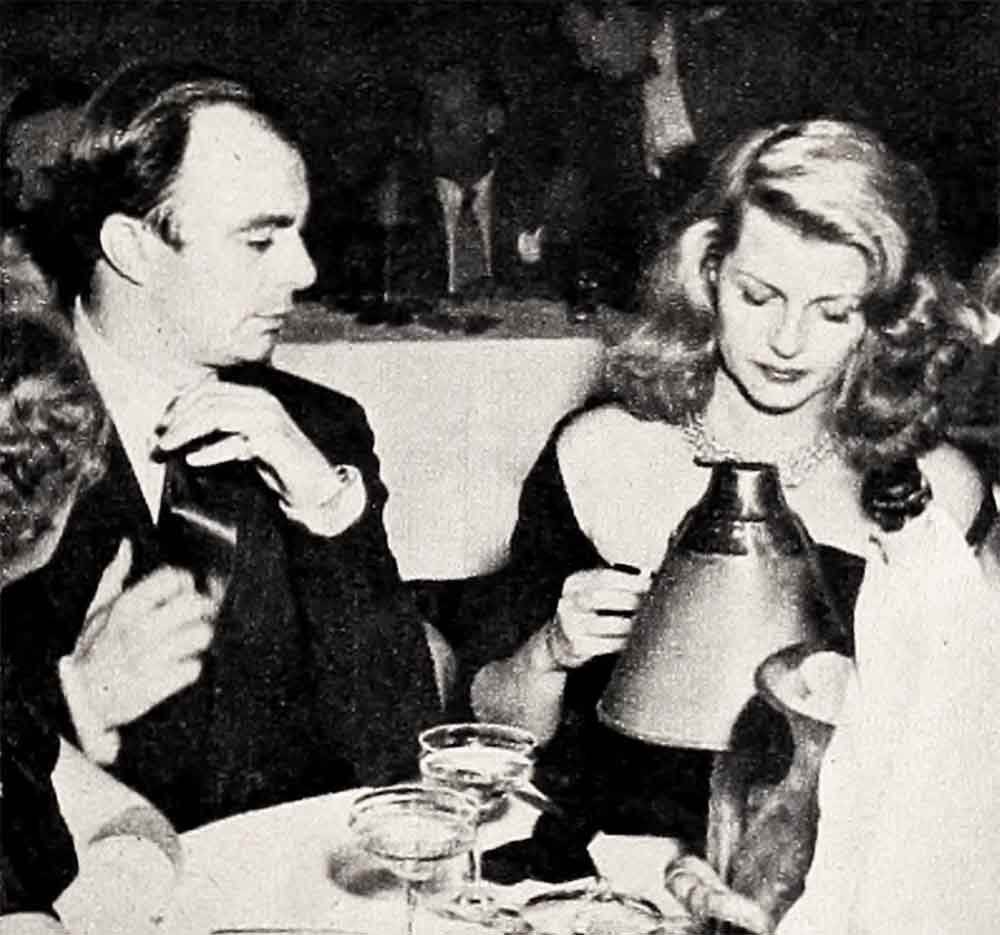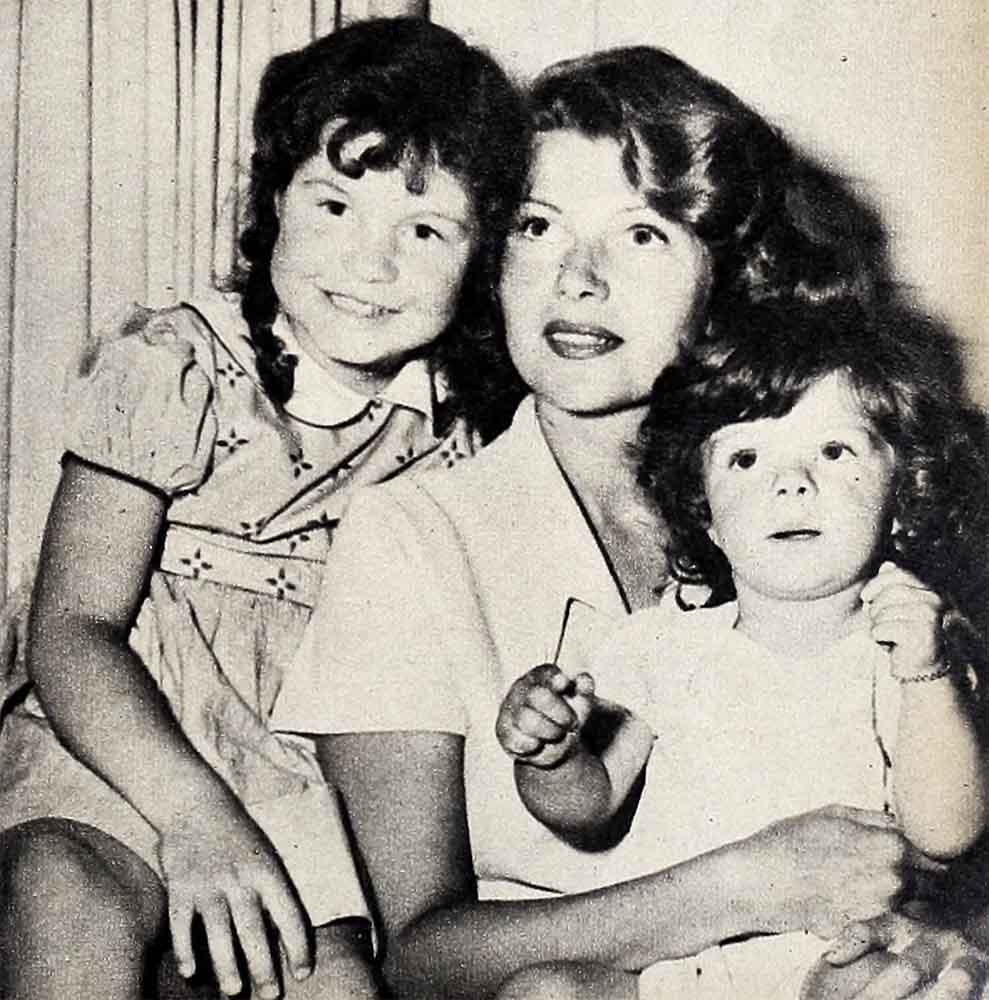
The Not-So-Private Life Of Rita Hayworth
The head of publicity at Columbia Pictures is George Lait. One night, he was sitting around with his wife when their phone rang. The voice on the other end of the line belonged to Rita Hayworth. “What are you doing?” she asked.
“We’re reading,” said Lait.
“Can I come over?” Rita wanted to know.
Lait said sure, and Mrs. Lait put on a pot of coffee. Rita climbed into her car and drove over the hill to visit.
For a couple of hours, the three of them sat reading in the living room of the Lait house. At 12:30 a.m., Rita said, “Work tomorrow,” and left.
AUDIO BOOK
The next day four different gossip columns reported on Rita’s night out. They had her in four different nightclubs with four different men, and they had her all wrong.
There is love in Rita’s life these days. But it’s not of a romantic nature. Rita’s in love all right. She’s in love with her children. That’s enough for now. And then there is her career. once again it has come to count. For three years she ignored it s existence. However, even in temporary retirement, Rita was a star and the world couldn’t forget it. Now that she has returned to pictures, the spotlight will be even brighter. It will be focused primarily upon her work and her dates. And, of course, the things that mean the most to Rita—her home and family.
People sometimes ask if she wants her daughters to be actresses. At the question, Rita laughs. “How can you discuss futures for such young babies? Just let them be happy.”
She’s seeing to it that they are—and she’s happy to tell the world.
When Rita’s away from home, the roost is mainly ruled by a houseman named Domingo, who feels he owns the entire family. At Christmas time; Domingo hired an artist to come in and decorate the windows with snowmen, and Santa Clauses, and trees, and Rita didn’t know anything about it until the job was finished.

Recently, Domingo averted a domestic crisis. Rita had heard that Alaskan Huskies were wonderful dogs with children, so she bought a pair. They were wonderful dogs. They were also monumental, and when Rita looked at all that latent dog power looming over her children, she got worried. The Huskies had to go. But Rebecca and Yasmine had grown to like having dogs around the house and at the Huskies’ departure they set up a howl.
Domingo disappeared from the scene of battle, and returned sometime later with a small animal. ‘Nice dog,” he said. “Cost one dollar-fifty.”

The small animal—of mixed parentage— was promptly named Shorty and is now a great social success.
Rebecca, Rita’s daughter by Orson Welles, speaks French beautifully, and acts pretty grown up nowadays; Yasmine speaks a kind of hybrid French-English, and acts any way that comes to mind.
She’s a charmer, who flirts continually, lowers her head, glances up from under her lashes, and throws kisses. She visited Rita at the studio one day, watched her dance, and was utterly captivated. Rita came home that night and there was Yasmine, whirling like a dervish and shouting “I can do it, too, Mama. I can do it, too.”
Already Yasmine is denting men’s hearts. Her nurse, Ann, takes her to the park every afternoon while Rebecca is at day camp, and in the park the little boys fail under Yasmine’s spell. Donna Reed, listening to her small son Tony pray one night heard him mutter, “And God bless Jazz-min,”
Subsequently, Tony informed his mother that he was in love with Jazz-min, and could she please come to his birthday party?
Donna made a trip to the park to discover the identity of the lady. She turned out to be our girl, looking up from under those lashes.

Rita keeps Aly up-to-date on Yasmine by sending him photos. “She looks exactly like you,” Rita tells Aly. “Ridiculous,” he writes back. “She is your image.”
Once, when Rita was trying to snap some photos, Yasmine insisted on standing on her head. Getting up there was easy enough, but an astute observer who happened to be present, detected a hole the size of a dime in the sole of Yasmine’s sandal. “Ho-ho,” he cried. “A little princess with holes in her shoes!”
Obviously, an actress who earns $252,000 a year plus gravy (twenty-five per cent of the profits from each picture) can keep a little princess in Cadillacs, not to mention shoes. But with Yasmine, the shoe problem is high finance. She can and does wear out a pair a week. The only time she’s not in motion is when she’s sleeping.
Shoes aren’t all that take punishment. On a recent morning, Yasmine whipped up a small tornado in her boudoir because she couldn’t find a particular dress. Rita had bought the dress only a week before, and had just thrown it away. Within that time her daughter had worn it to shreds.
Then there was the case of the white, iridescent bathing suits. Both Rebecca and Yasmine ha gotten one. Rebecca strutted about in her suit like a proud beauty. Yasmine let her suit take her down to the pool and coming back she crawled up the forty rustic stone steps of the terrace. That suit was finished.

Rebecca is taking dancing lessons at her own request. And Rita sometimes sits on the floor and plays Bongo drums while both kids cut a rug.
The girls have a good time with their mother and hate having her away. “Why do you have to leave us?” Rebecca asks, very reasonable and grown-up, but with tears in her eyes, and a trembling voice.
Rita dislikes separations, too, yet once in a while there is something she feels she just has to do—like the hospital tour last fall. She traveled from San Francisco to Seattle, visiting hospital wards.
It was Rita’s own idea. She had no publicity. She paid all expenses for herself and her secretary, and even the expenses of an Army major who accompanied them.
Many stars are asked to visit the war-wounded, and many do; but Rita is the first big-name star to pick up and go on her own.
She was separated from her children again when she vacationed in Mexico after “Affair in Trinidad,” but it’s simply a matter of common sense for her to take a rest once a movie is completed.

Rita and her secretary went to Mexico in a station wagon. They covered three thousand miles, spent their first night in Phoenix, their second in Texas, and crossed the border on the third night.
They rested for a few days in San Miguel, then motored to Mexico City where they behaved like tourists. They visited an art school, cathedrals, missions and shopped for hats.
Next stop: Acapulco. Rita stayed at the Casablanca Hotel, played golf every day (she shoots in the nineties), swam in the ocean, lolled for hours on the sundeck. At night she went dancing with the local escorts. Sometimes in the nightclubs, sometimes barefoot on the sand.
It would have been a wonderful vacation. However, while she was there she received word that both her father and her grandfather had suddenly taken ill.
The Cansino men recovered, but for a long time after Rita flew back, her grandfather had to remain in the hospital, and kept asking to see her. She’d finish work, then dash down to spend an hour with him before going home to the kids. They spoke Spanish to one another, while the old man’s eyes glowed with happiness. Rita is his favorite grandchild and not because she’s a movie star. He’s not impressed with that—all the Cansinos have been performers.
Padre, as he’s called by the whole family, and Rita have always been very close. The old man was once a bullfighter, and together he and Rita started a magnificent collection of bullfight paintings.

Rita is not a drinker, but when Padre was around there was always a jug of Spanish wine in the kitchen. He’d go out, take a deep slug and then come back and start talking bullfighting, while his granddaughter listened raptly for the hundredth time, as though she had never heard him tell his stories before.
Rita’s interest in art started with the bullfight posters, but it hasn’t ended there. She met Picasso while she was abroad, and he gave her a painting of his, and she bought others. Now her house is filled with priceless pictures, and she has a record collection that’s equally fine. About reading, she’s less selective. She once went on a location trip with four twenty-five-cent detective novels, and Tolstoi’s “War and Peace.”
Rita, now on her second picture since she came home, is back in real harness again. She gets to the studio at six-thirty in the morning, and sometimes doesn’t leave until eight-thirty at night. She’s now a producer at Columbia, so things that do not concern other actresses do concern Rita. And for a lazy girl, she’s holding up pretty well. She is ambitious for herself as an actress.
This ambition was probably inherited, all the Cansinos knew about was plugging away in show business, and Rita took her work seriously until she met Aly. Then, for the first time in her life, she walked off a picture. Furthermore, up until Aly, she’d never read a newspaper except for the funnies, and she couldn’t have worried less about world affairs.
Now, she’s got all kinds of political savvy, which seems to be the main change from the old Rita. She can talk to people who aren’t “in the business” without getting tongue-tied. A close associate of Rita’s says a conversation with her used to go like this:
“Gee, business smelled in Milwaukee.”
Well, it rained.”
Well, it’s always bad in Milwaukee when it rains.”
Today, Rita knows intimately premiers and potentates, and could argue for hours on matters of State and political trends.
If she had the hours in which to argue.
Except for broadening of knowledge and horizons, they say at Columbia that Rita hasn’t changed a bit. And they say it on every level—carpenters, designers, grips, vice-presidents. They remember wondering what it would be like when she came home. After three years as a Princess, and manager of what was practically an International hotel—what kind of grand entrance would she make, how hard would she try to impress everybody?
Bob Coburn, head of Columbia’s still department, who has been photographing Rita since her first picture there, tells the way it happened.
“I had the gang with me,” he says, “and she walked in and we had a sign that said, ‘Welcome Rita.’ She ran around and hugged everybody, and it was just as if she’d walked out the night before. It was a touching home-coming.”
Coburn sounds reverent when he talks about Rita. “She never will be a jerk like some of the others,” he says. “You shoot ’em for the first time when they’re nobody, and two or three years later they give you the ultra-ultra stuff . . .”
You’ll get the same story from Jean Louis, Rita’s wardrobe designer. Jean is impressed by her natural, friendly manner. The kind of manner that makes everyone feel like her pal.
Jean tells of the afternoon he was coming out of the studio and a man ran up to him.
“Hello, Jean. Do you remember me?”
Jean didn’t, but being a friendly soul himself, he hedged. “Well, your face is familiar.”
“Hattie Carnegie!” the man cried.
Then Jean realized, When he’d worked at Hattie Carnegie’s swank establishment in New York, this fellow had been the doorman.
“Jean,” the man said. “Get me in to see Rita.”
“I can’t,” Jean said. “I’m not allowed on the set myself. They chase me out when I come around.”
“But, Jean . . said the man, “I know Rita.”
“Yes?” said Jean.
“Yes,” said the man. “Not only do I know her; I know her very well.”
“How do you know her so well?” asked Jean.
“From opening the door for her!” his friend said, triumphantly.
A typical working day for Rita starts at ten minutes to six in the morning. That’s when the alarm goes off. Rita leaps out of bed into her jeans, has orange juice and a quick cup of coffee, then drives to the studio. By six-thirty Helen Hunt is bleaching Rita’s hair, Helen Daniels (Rita’s maid) is up in Rita’s studio suite preparing breakfast, and Maggie Parker (Rita’s secretary) is at Rita’s elbow drawing up shopping lists or reading the morning mail.
Somewhere between the bleach job and the shampoo, Rita will dash upstairs to her suite (sitting room, make-up room, kitchen and bath) for breakfast. Bacon and eggs if it’s an ordinary working day. Lots more if she has to dance.
Back again with Helen Hunt, Rita’s amber bronze hair is washed and brushed dry. Then she’s ready for work. The work never lets up, either.
After a day as Actress Rita rehearsing and shooting, Producer Rita has to see the rushes, read Scripts, puzzle over advertising contracts.
Getting back to the rumors about Rita and men, they -the rumors—go on. An old friend like Gilbert Roland will drop over to her house one afternoon with a book she wants to read: reporters report, What’s between Roland and Rita.” Kirk Douglas will invite her to his place for a quiet dinner and maybe dancing at Ciro’s, and photographers will swarm all over them. Richard Greene will take her to lunch at Tail O’ The Cock. This will be in the morning edition: “Richard Greene and Rita Hayworth are making the nightclubs their playground.”
This kind of talk is dangerous for Rita. She’s in the midst of a divorce case with a couple of probabilities as to its cutcome. Though she filed for divorce some months ago, the court hearing is still in the future.
But, in August, Rita’s lawyer, Bartley Crum, announced that she had agreed not to serve any papers on Prince Aly Khan while he is in the United States for a brief family reunion. This, intimate friends indicate, might develop into a permanent reunion.
The “mystery” that surrounds Rita at present is no mystery at all. She is finishing “Salome,” enjoying renewed friendships in Hollywood and having a wonderful time with her children.
If at times she is lonely, she’s busy enough hardly to notice it.
THE END
It is a quote. PHOTOPLAY MAGAZINE OCTOBER 1952
AUDIO BOOK




